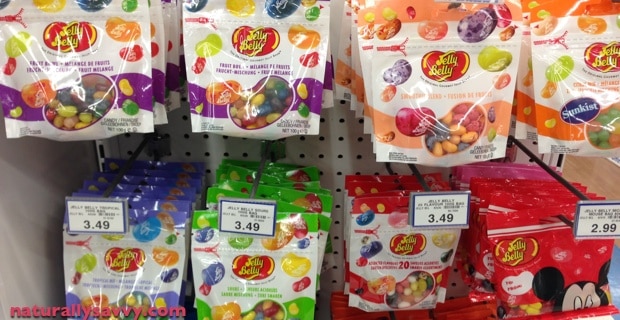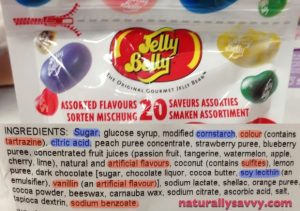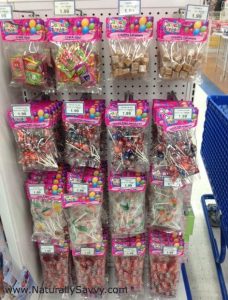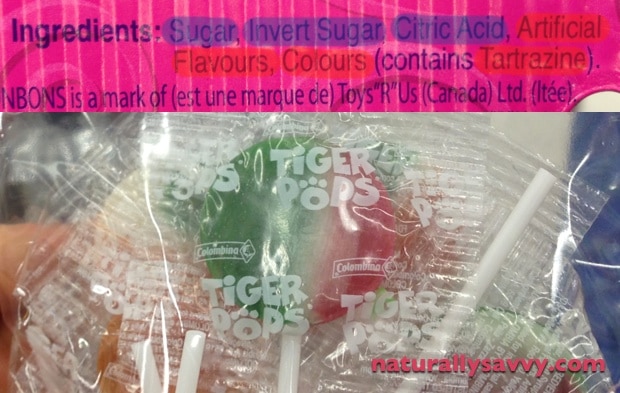
Candy dates back to prehistoric times, when honey was eaten straight from the beehive. The first known candy confections were fruits and nuts rolled in honey. Well, we've come a long way since then. Ninety seven percent of Americans buy candy every year, and we consume about 24 pounds of candy per person. That's a lot of candy!
When buying candy, read the labels. Purchase candy without artificial colors, flavors, sweeteners, or preservatives. When we wrote our book, Unjunk Your Junk Food, we found artificial colors to be the biggest culprit. Kids love to eat bright colors, so companies add artificial dyes, because they are cheap, to brighten them and make them look appealing. Do your kids ever come home from a birthday party with a loot bag full of candies found, most probably, at the dollar store? (Mine do, all the time. But they know better than to eat them. Instead, they hand them over to me so I can take pictures of them and post them on Naturally Savvy! LOL.)
Although Jelly Belly makes natural jelly beans, and they are currently experimenting with using spirulina for their green and blue colors, unfortunately the Toys "R" Us I shopped at only sold the artificially-colored kind.

As you can see, this bag of Jelly Belly Jellybeans I picked up at the store contains artificial colors, flavors, GMOs, and sodium benzoate, a preservative linked to allergic reactions, ADHD, and cancer. Note: This is a Canadian package so it doesn't fully list the types of artificial colors used – it merely states them as "colour." When we analyzed Jelly Belly's ingredients for our book(page 174), the colors listed in the ingredients of the 30 flavor variety were: Red 40 lake, Yellow 5 and 6 lake, Blue 1 and 2 lake, Yellow 5 and 6, Red 40, Blue 1 (color).
Tartrazine
This coal tar dye is also known as Yellow No. 5, or E102 (in food). It is an azo dye (similar in chemical structure to aspirin) and is used to color food, supplements, cosmetics and drugs yellow and green. According to CSPI, this dye has been shown to contain carcinogenic contaminants, and is linked to allergic reactions and hyperactivity in children. If your child is asthmatic, there has been some evidence it could exacerbate their symptoms so it's best to avoid it all together.
Other Candies
Standing in the middle of the main aisle are several racks of candies imported by a third party company, and distributed exclusively for Toys "R" Us. They are strategically placed on the way out of the store so children can easily pick up the packages, and beg their exhausted, and patience-less parents to buy it for them. [OK, maybe I'm projecting here because of how I feel after spending an hour, or more, walking around a toy store with three kids!]
Below is an example of one of the candy racks my kids spotted:

And pictured below are the ingredients in several of the packages I looked at:

What amazes me is that nowadays there are many options for healthier candy that are colored and flavored with organic fruits and vegetables, instead of chemicals. Examples of some of these healthier option include:
- Surf Sweets (they make a variety of candy from jelly beans, to gummies, to sours, peach and watermelon rings, and fruity hearts);
- TruJoy Sweets (they make organic candy canes that taste BETTER than the conventional ones, and they just launched their organic fruit chews);
- Yummy Earth (You may have seen a few SKUs of this product at Toys "R" Us. They make organic lollipops);
- Go Naturally (organic hard candies);
- Newman's Own Organics (my whole family LOVES their licorice and chocolate cups);
- Unreal Brands (they make a great alternative to M&M's).
- Sun Cups (these are amazing! They taste a lot like Reese's Peanut Butter cups, but they are peanut and gluten free. They use sunflower butter in place of peanut butter so they are safe for kids with peanut allergies).
If you chew gum, here are some healthier options as well:
- Glee Gum (they make natural chewing gum with NO artificial sweeteners, flavors, colors, or preservatives. They are also Non-GMO Project certified);
- Xylichew (they have five different flavors).
If you are looking to purchase healthier candy options, check out Natural Candy Store.
Continue Reading:
- Easy Bake Ovens & Other Desserts
- Blizzard & Slurpee Makers
- Jelly Belly Jelly Beans & Other Candy
- TM! Cosmetics
- Tattoos, Body Art, Scented Toys, and Other Cosmetics
- Exiting the Store Through a World of Junk Food
- References




